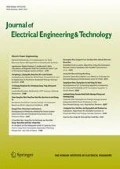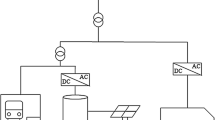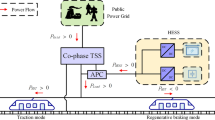Abstract
This paper proposes an approach for the optimal operation of electrified railways by balancing energy flows among energy exchange with the traditional electrical grid, energy consumption by accelerating trains, energy production from decelerating trains, energy from renewable energy resources (RERs) such as wind and solar photovoltaic (PV) energy systems, and energy storage systems. The objective function considered in this work is the minimization of total operating cost of electrified railway system consisting of cost of power generation from the external power system, cost of power obtained from RERs such as wind and solar PV sources, cost of power from storage systems such as battery storage and supercapacitors, and the income obtained by selling excess power back to the main electrical grid. This problem is formulated as an AC optimal power flow problem subjected to various equality and inequality constraints. In this work, the probability distribution functions (PDFs) are used to the uncertainties related to wind and solar PV powers. The proposed optimization problem is solved by using CONOPT solver of generalized algebraic modeling system (GAMS) software, which is a powerful and efficient optimization tool. The simulation results obtained with GAMS/CONOPT solver are also compared with meta-heuristic based differential evolution algorithm (DEA).








Similar content being viewed by others
References
Khodaparastan M, Mohamed AA, Brandauer W (2019) Recuperation of regenerative braking energy in electric rail transit systems. IEEE Trans Intell Transp Syst 20(8):2831–2847
Young B, Ertugrul N, Chew HG (2016) Overview of optimal energy management for nanogrids (end-users with renewables and storage). In: Australasian Universities power engineering conference, Brisbane, pp 1–6
Huang X, Liao Q, Li Q, Tang S, Sun K (2020) Power management in co-phase traction power supply system with super capacitor energy storage for electrified railways. Railw Eng Sci 28:85–96
Aguado JA, Racero AJS, de la Torre S (2018) Optimal operation of electric railways with renewable energy and electric storage systems. IEEE Trans Smart Grid 9(2):993–1001
Moazzami M, Moradi J, Shahinzadeh H, Gharehpetian GB, Mogoei H (2018) Optimal economic operation of microgrids integrating wind farms and advanced rail energy storage system. Int J Renew Energy Res 8(2):1155–1164
Sumpavakup C, Ratniyomchai T, Kulworawanichpong T (2017) Optimal energy saving in DC railway system with on-board energy storage system by using peak demand cutting strategy. J Mod Transport 25:223–235
Kumar H, Yadav SK, Sahay K, Kumar SS (2019) Investigation on recuperation of regenerative braking energy using ESS in (Urban) rail transit system. In: International conference on electrical, electronics and computer engineering (UPCON), Aligarh, India, pp 1–6
Wu X, Hu X, Yin X, Moura SJ (2018) Stochastic optimal energy management of smart home with PEV energy storage. IEEE Trans Smart Grid 9(3):2065–2075
Khan N, Dilshad S, Khalid R, Kalair AR, Abas N (2019) Review of energy storage and transportation of energy. Energy Storage 1(3):e49
de Matos JG, Silva FSF, Ribeiro LAS (2015) Power control in AC isolated microgrids with renewable energy sources and energy storage systems. IEEE Trans Ind Electron 62(6):3490–3498
Ratniyomchai T, Hillmansen S, Tricoli P (2014) Recent developments and applications of energy storage devices in electrified railways. IET Electr Syst Transport 4(1):9–20
Almehizia AA, Al-Masri HMK, Ehsani M (2019) Integration of renewable energy sources by load shifting and utilizing value storage. IEEE Trans Smart Grid 10(5):4974–4984
Cui G, Luo L, Liang C, Hu S, Li Y, Cao Y, Xie B, Xu J, Zhang Z, Liu Y, Wang T (2019) Supercapacitor integrated railway static power conditioner for regenerative braking energy recycling and power quality improvement of high-speed railway system. IEEE Trans Transport Electrif 5(3):702–714
Ovalle A, Pouget J, Bacha S, Gerbaud L, Vinot E, Sonier B (2018) Energy storage sizing methodology for mass-transit direct-current wayside support: application to French railway company case study. Appl Energy 230:1673–1684
Kotel’nikov AV, Shevlyugin MV, Zhumatova AA (2017) Distributed generation of electric energy in traction power-supply systems of railways based on wind-power plants. Russ Electr Eng 88:586–591
Bade SK, Kulkarni VA (2018) Analysis of railway traction power system using renewable energy: a review. In: International conference on computation of power, energy, information and communication, Chennai, pp 404–408
Park S, Salkuti SR (2019) Optimal energy management of railroad electrical systems with renewable energy and energy storage systems. Sustainability 11:6293
Dragičević T, Pandžić H, Škrlec D, Kuzle I, Guerrero JM, Kirschen DS (2014) Capacity optimization of renewable energy sources and battery storage in an autonomous telecommunication facility. IEEE Trans Sustain Energy 5(4):1367–1378
de la Torre S, Racero AJS, Aguado JA, Reyes M, Martínez O (2015) Optimal sizing of energy storage for regenerative braking in electric railway systems. IEEE Trans Power Syst 30(3):1492–1500
Ata M, Erenoğlu AK, Şengör İ, Erdinç O, Taşcıkaraoğlu A, Catalão JPS (2019) Optimal operation of a multi-energy system considering renewable energy sources stochasticity and impacts of electric vehicles. Energy 186:115841
Das B (2014) Uncertainty modelling of wind turbine generating system in power flow analysis of radial distribution network. Electr Power Syst Res 111:141–147
Vinod RK, Singh SK (2018) Solar photovoltaic modeling and simulation: as a renewable energy solution. Energy Rep 4:701–712
Technologies and potential developments for energy efficiency and CO2 reductions in rail systems. Technical Report. https://uic.org/IMG/pdf/_27_technologies_and_potential_developments_for_energy_efficiency_and_co2_reductions_in_rail_systems._uic_in_colaboration.pdf
Javaid N, Hafeez G, Iqbal S, Alrajeh N, Alabed MS, Guizani M (2018) Energy efficient integration of renewable energy sources in the smart grid for demand side management. IEEE Access 6:77077–77096
Ćalasan MP, Nikitović L, Mujović S (2019) CONOPT solver embedded in GAMS for optimal power flow. J Renew Sustain Energy 11(4):046301
Raja SC, Banu SAW, Venkatesh P (2012) Congestion Management using GAMS/CONOPT solver. In: IEEE-international conference on advances in engineering, science and management, Nagapattinam, pp 72–78
Tian H, Shuai M, Li K (2019) Optimization study of line planning for high speed railway based on an improved multi-objective differential evolution algorithm. IEEE Access 7:137731–137743
Birogul S (2019) Hybrid Harris hawk optimization based on differential evolution (HHODE) algorithm for optimal power flow problem. IEEE Access 7:184468–184488
Novak H, Vašak M, Gulin M, Leši´c V (2015) Railway transport system energy flow optimization with integrated microgrid. In: 12th international conference on modern electrified transport, Trogir, Croatia, pp 1–6
Novak H, Vašak M, Leši´c V (2016) Hierarchical energy management of multi-train railway transport system with energy storages. In: IEEE international conference on intelligent rail transportation, Birmingham, pp 130–138
Acknowledgements
This research work has been carried out based on the support of “Woosong University's Academic Research Funding—(2019–2020)”.
Author information
Authors and Affiliations
Corresponding author
Additional information
Publisher's Note
Springer Nature remains neutral with regard to jurisdictional claims in published maps and institutional affiliations.
Rights and permissions
About this article
Cite this article
Salkuti, S.R. Optimal Operation of Electrified Railways with Renewable Sources and Storage. J. Electr. Eng. Technol. 16, 239–248 (2021). https://doi.org/10.1007/s42835-020-00608-1
Received:
Revised:
Accepted:
Published:
Issue Date:
DOI: https://doi.org/10.1007/s42835-020-00608-1




